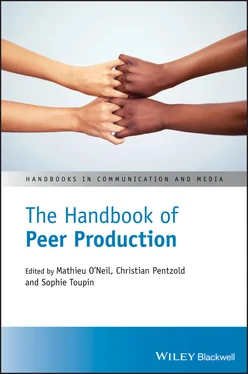To set the groundwork for understanding cultures of peer production, this chapter argues that it is necessary to see that peer production is, by and large, a form of cultural production . Cultural production refers to aesthetic and intellectual forms of production, from literature and music to journalism and academic scholarship. It may seem strange at first to compare the production of open source software or Wikipedia to these fields, since for example we often think of traditional cultural production as an individual pursuit (ignoring how such practice is always collaborative (Becker, 1984)). In the following, I show how this analogy and corresponding theory helps us to see how (1) peer production projects are clearly embedded in existing cultural fields, and often represent an autonomous form of production that seeks to resist certain economic and political pressures in favor of core values such as meritocracy and openness and (2) such autonomy is achieved through the enactment of those core values, which are in turn related to the social hierarchies, forms of exclusion, and other limitations that characterize these projects and the groups of people who populate them.
2 Overview and Limitations
The chapter synthesizes existing research to produce a framework for understanding cultures of peer production. I argue that the cultures of peer production projects will tend to be characterized by autonomy , meritocracy , openness , and inspiration , with each of these concepts corresponding to one of the following sections. In Section 3, I discuss the autonomy of peer production projects and their position within larger fields of software and media production, or what might be described as a larger field of “tech” or the field of new media production (Stevenson, 2016). The distinction of peer production projects is closely related to core values and assumptions, in particular meritocracy , and Section 4examines this value and the cultural practices associated with it. Section 5discusses openness as a key value and disposition within peer production cultures, elaborating on this with examples such as Wikipedia’s “good faith collaboration” (Reagle, 2012). Section 6asks what kind of moral “order of worth” (Boltanski & Thévenot, 2006) justifies commitment to peer production projects, and argues that we should especially consider the role of inspiration and the importance of the affective dimension of contributing to these projects.
In this introduction to the cultures of peer production, I have made various decisions that should be noted. First, this chapter draws its framework largely from Bourdieu’s field theory (1993) and Boltanski and Thévenot’s sociology of critique (2006). In addition to the fact that a number of other sociological theories have been used to make sense of cultures of peer production, it should be noted that the theories I have chosen contain significantly different assumptions: critics argue that Bourdieu’s theory does not account for the agency of individuals, something that Boltanski and Thévenot specifically aim to address by arguing that individuals reflect on their actions and seek to justify them through appeals to various kinds of valuation, or “orders of worth” (see, e.g., O’Neil, 2011 for a discussion of this difference). Despite this internal inconsistency, I have chosen this combination as it helps to highlight (1) the relational forms of structure that give meaning to peer production projects and actions within them, for example through oppositions that actors draw between autonomy and commercial or political influence, and (2) how participants justify their commitment to these projects and specific actions within them. Second, although some definitions of peer production include entities such as Google’s search engine (which analyzes the hyperlinks produced by a decentralized group of actors in order to produce better search results), this chapter draws on a specific subset of commons‐based peer production based on intentional collective action, specifically Wikipedia and free and open source software (FOSS) production. In addition to their intentional nature, in Bourdieu’s terminology I am limiting my examples to “autonomous” examples of peer production, at the expense of more commercial forms. For example, one can study Reddit’s platform for news and discussion or Amazon’s platform for consumer reviews as peer production, as these contain many of the same principles for the decentralized creation of value. Likewise, there are examples of open source production that are perceived as more “closed,” such as the Android OS (Currie et al., 2013). I would argue that more commercial or closed forms of peer production lack the degree of autonomy found in Wikipedia and many open source communities, as discussed in the next section. My normative position is that these autonomous communities should be studied with the intent of serious critique and engagement that can ultimately be put to use in making them stronger and helping them live up to the lofty ideals they set for themselves. That said, it must be noted that the values and practices I identify can and often will be present in commercial forms of peer production, if not to the same degrees or articulated in the same ways. Finally, my emphasis here is on describing a framework rather than providing exhaustive detail about specific communities or cultures – my hope is that supplying a “bigger picture” at the expense of rigorous description will help readers to compare and contrast the different cultures of peer production they will encounter in this Handbook and elsewhere.
Field theory helps us to see how peer production projects are situated in broader structures of power. With this framework, Bourdieu (1993) outlines how society consists of fields, semi‐autonomous domains of social activity. In addition to fields of power (i.e., the fields of politics, economics, and law) there are cultural fields that Bourdieu defines as fields of aesthetic and intellectual production: art, journalism, and academia would fit this description. All fields are semi‐autonomous: on the one hand they have an independence demonstrated through internal consistency – shared “rules,” values, practices and so on; on the other hand, they continually impact one another to differing degrees. The journalistic field certainly impacts the fields of political and economic power, for example, but not to the same degree that it is in turn shaped by them. Internally, fields are shaped hierarchically, meaning actors have different levels and kinds of power. According to Bourdieu actors are also positioned in relation to two poles: towards the field’s autonomous pole actors demonstrate a capacity to resist pressures from outside fields (in particular political and market pressures), whereas towards the field’s heteronomous pole they are less likely to demonstrate a commitment to the field’s autonomous values. In the sense used here, autonomy refers to the autonomy of a peer production project rather than the autonomy of individuals working on that project (although that is also a key part of the cultures of peer production).
To make this more concrete, think of how FOSS production relates to (1) mainstream and proprietary software production and (2) market pressures. FOSS is often understood as having a dichotomous relationship with proprietary software, for example Linux vs. Apple/Microsoft. In this sense Linux distributions like Debian and Ubuntu seek to distinguish themselves as autonomous actors in comparison to the heteronomous positions of large companies who are more likely to bow to market demands and political restrictions. They do this not just through the fact that they make their source code freely available, but also by enacting sets of values that they perceive to be lacking in mainstream commercial development, such as a commitment to open technological standards, improving access to computing, or allocating resources to projects or solutions they deem technically superior. They thus actively pursue autonomy as they perceive it. They oppose market pressures in different ways, not just through their opposition to intellectual property regimes but also to certain judgments of quality (e.g., Debian prides itself on being an operating system geared towards other software developers). Importantly, Bourdieu consciously uses the term “semi‐autonomy”: pressures from the market, state, and other fields are always present, but it is a matter of degree.
Читать дальше


![О Генри - Справочник Гименея [The Handbook of Hymen]](/books/407356/o-genri-spravochnik-gimeneya-the-handbook-of-hymen-thumb.webp)









